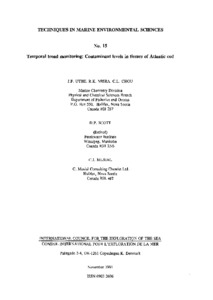| dc.identifier.citation | Uthe, J. F.; Misra, R.K.; Chou, C.L.; Scott, D.P. and Musial, C.J. (1991) Temporal trend monitoring: Contaminant levels in tissues of Atlantic cod. ICES Techniques in Marine Environmental Sciences, No. 15, 11pp. DOI: http://dx.doi.org/10.25607/OBP-251 | en_US |
| dc.description.abstract | The
study
of
trends
in
trace
contaminant
concentrations
in
marine
species
has
been
of
interest
to
the
International
Council
for
the
Exploration
of
the
Sea
(ICES)
since
the
early
1970s.
The
investigation
of
temporal
trends
in
contaminant
levels
in
fish,
both
as
monitors
of
their
environment
and
from
a human
health
concern,
is
a topic
under
consideration
by
the
ICES
Working
Group
on
the
Statistical
Aspects
of
Trend
Monitoring
(WGSATM)
as
a part
of
the
Cooperative
ICES
Monitoring
Studies
Programme
(CMP).
Many
problems
were
encountered
during
the
first
attempts
by
WGSATM
to
analyse
the
CMP
data.
In
addition
to
the
presence
of
outlying
observations
and
significant
differences
between
years
in their
coefficients
of
regression
of
(log)
contaminant
level(s)
on
(log)
biological
variable(s),
many
inconsistencies
were
found
in
the
annual
sampling
structures
(Anon.,
1987).
These
often
reflected
the
inability
to
replicate
the
size
(length,
age)
structure
characterizing
earlier
samples
and
the
failure
to
obtain
a
sufficiently
wide
range
in
the
covariables
selected
for
study.
These
inconsistencies
affected
the
annual
regression
lines,
yielding,
in
many
instances,
insignificant
regressions.
Further
discussion
within
WGSATM
identified
many
sampling
and
handling
differences
which
probably
arose
from
the
too
general
nature
of
the
past
guidelines
for
trend
monitoring.
The
Working
Group
emphasized
the
importance
of
essentially
identical
structures
within
all
samples
comprising
a temporal
trend
study
and
emphasized
that
trend
monitoring
can
only
be
done
effectively
if
all
steps
of
the
study
are
thoroughly
described
and
properly
followed
by
all
participants.
Therefore,
the
WGSATM
recommended
that
a series
ofleaflets
be
prepared
giving
specific
details
of
sampling,
handling,
and
analysis
for
each
species
being
studied.
The
first
leaflet
(Vthe
et al.,
1991)
is
a general
introduction,
describing
the
problems
and
requirements
when
monitoring
temporal
trends
in
contaminant
levels
in
the
marine
environment,
particularly
biota.
This
document
describes
the
Canadian
techniques
used
to
study
temporal
trends
in
contaminant
levels,
both
tissue
concentrations
and
burdens
(tissue
concentration
times
the
total
weight
of
that
tissue
in
the
animal),
in
individual
Atlantic
cod
(Gadus
morhua)
muscle
and
liver
tissues
over
the
period
1977-1985.
The
decision
to
study
Atlantic
cod
was
based,
inter
alia,
upon
the
importance
of
this
species
to
Canada
and
the
North
Atlantic
community,
its
widespread
distribution
within
the
ICES
area,
and
the
identification
of
a relatively
discrete
and
stable
cod
stock
in
the
southern
Gulf
of
St.
Lawrence.
The
procedural
descriptions
which
follow
are
given
only
in
outline
form,
along
with
the
bases
upon
which
such
procedures
were
developed.
Full
details,
including
the
statistical
analyses
carried
out
on
the
data,
are
given
in
the
following
references:
Scott
et al.
(1978,
1981,
1983),
Misra
et
al.
(1988,
1989a,b,c),
and
Misra
and
Vthe
(1985,
1986,
1987a,b).
The
chemical
analytical
procedures
for
the
measurement
of
trace
contaminants
are
not
considered
here,
but
are
included
in
the
above-mentioned
references. | |
 Repository of community practices in Ocean Research, Applications and Data/Information Management
Repository of community practices in Ocean Research, Applications and Data/Information Management
